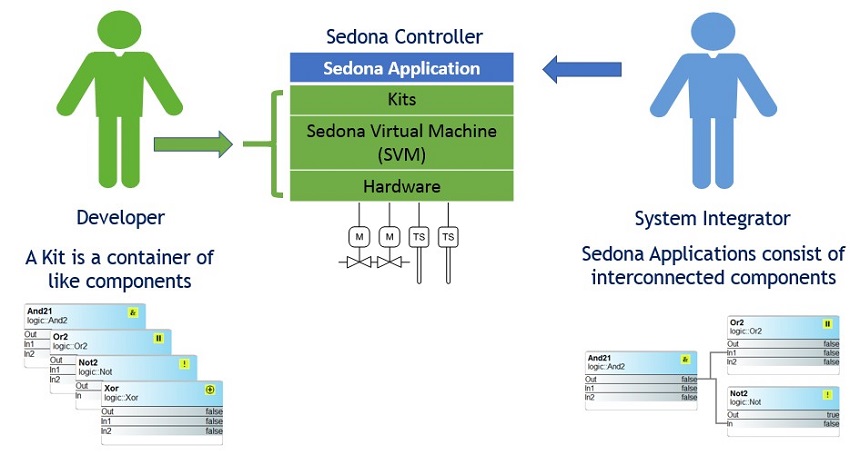This makes programming quicker and certainly easier as components are enhanced, become more powerful, and offer completely new capabilities to users.

Zach Netsov,
Product Specialist,
Contemporary Controls
|
September 2018 |
[an error occurred while processing this directive] |
| Sharing of Custom Sedona Kits,
Components and Tools This makes programming quicker and certainly easier as components are enhanced, become more powerful, and offer completely new capabilities to users. |
 Zach Netsov, Product Specialist, Contemporary Controls |
| Articles |
| Interviews |
| Releases |
| New Products |
| Reviews |
| [an error occurred while processing this directive] |
| Editorial |
| Events |
| Sponsors |
| Site Search |
| Newsletters |
| [an error occurred while processing this directive] |
| Archives |
| Past Issues |
| Home |
| Editors |
| eDucation |
| [an error occurred while processing this directive] |
| Training |
| Links |
| Software |
| Subscribe |
| [an error occurred while processing this directive] |
Sedona is a component-based programming framework for embedded networked control devices. Sedona platforms (devices) execute logic onboard in an SVM (a Sedona Virtual Machine) which is the interpreter. Logic functionality is provided by developers - manufacturers of Sedona platforms in the form of function blocks called Components. An editor Tool such as the free Sedona Application Editor (SAE) running on your PC lets you configure and link Components together to create the wiresheet control logic (application) running in the Sedona platform. To make programming easier and keep things organized, Components are grouped by similarity of their functionality into Kits — which are basically containers of alike Components. All Kits are released by developers in an even larger container called the Component Bundle. The Component Bundle is loaded into the editor Tool and usually supports several Sedona devices. The Bundle is updated as new devices, or new custom components are released by the Sedona, device manufacturer. New Component Bundle release means new Kits, new Kits means new Components, and new Components means new or enhanced functionality to the user. This is the foundation of component programming. The idea is that more functionality is made available to users as new Components are released whether they have enhanced Components or completely new or custom Components. This makes programming quicker and certainly easier as components are enhanced, become more powerful, and offer completely new capabilities to users.

In addition to the ease of programming and continuous improvement of functionality, Sedona provides the best opportunity for creating open and interoperable controllers. Today, Sedona is used as the go-to programming methodology by several controls manufacturers, which brings up the question of compatibility of Kits, Components, and Tools between different Sedona devices from different manufacturers. Sedona does offer compatibility between devices and sharing of Kits, Components, and editor Tools is possible and encouraged by the Sedona Community. Some things need to be considered as we go forward with Sedona.
There are basically two main types of Components to discuss – hardware
dependent and hardware independent. Hardware dependent Components rely
on the firmware in the Sedona device to provide native functions such
as built-in I/O, BACnet Client capability, an EIA-485 port, etc. A
hardware dependent Component relies on functions implemented in the
specific device’s firmware in order to operate. These components will
only work on devices which they were designed to support (usually by
the same manufacturer), and this affects the compatibility of these
Components between different Sedona platforms, especially if the
platforms are from different manufacturers. However, the second type -
hardware independent Components are purely logical and do not rely on
device firmware and native functions. This makes hardware independent
Components transferrable between Sedona platforms regardless of the
manufacturer or firmware on the device. This compatibility of Kits and
Components across platforms means that there is an opportunity to share
hardware independent Components, and more functionality can be made
available to the Sedona Community.
[an error occurred while processing this directive]Sedona editor Tools are interoperable by nature, but this interoperability needs to be maintained by the developers. There are a few Sedona editor Tools out there. There is Tridium’s Workbench AX 3.8, Contemporary Controls’ Sedona Application Editor (SAE), GC5’s iSMA Tool, and Easy IO’s CPT Tools. Most of these tools, except for Workbench AX are license-free, do not require you to join a distribution channel, and are easy to obtain. The question is whether these developers/manufacturers will maintain interoperability in the future and allow their tools to be used by others. Different Sedona manufacturers’ tools can be used across Sedona platforms as long as the correct Component Bundle is installed in the editor Tool. The Sedona Kits and Components in the tool must match the ones in the Sedona target platform. I have done some Sedona editor Tools interoperability testing of my own, and so far, I have proven that these tools are mostly compatible across different Sedona platforms with a few minor exceptions. This could certainly be smoothed out with the help of the developers in the future.
The Sedona Alliance represents the interests of a community of developers, system integrators, and users promoting the use of Sedona as an open control programming environment. Development of the technology is now being recognized by a Sedona Community interested in keeping this open-source technology open for all to use. The mission of the Sedona Alliance is to promote Sedona as the premier open control programming environment available for use by the public without restrictions. The Alliance represents the interests of a Sedona community consisting of developers who make Sedona products, integrators that create Sedona applications, and users that benefit from its deployment. The Sedona Alliance encourages and is willing to host free downloads of hardware independent Sedona Kits and Components for the benefit of the community.
About the Author
Zach
Netsov is a Product Specialist at Contemporary Controls focused on the
BASautomation line of products which provide solutions for both small
and scalable building management. He received his BSEE from DeVry
University with a concentration in renewable energy. At Contemporary
Controls, Zach is part of the team that championed the design and
creation of a BASpi I/O board for Raspberry Pi.
[an error occurred while processing this directive]
[Click Banner To Learn More]
[Home Page] [The Automator] [About] [Subscribe ] [Contact Us]